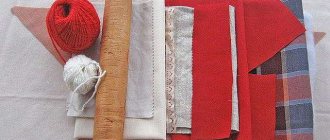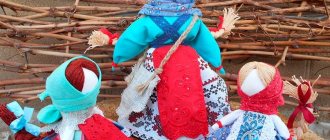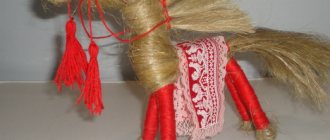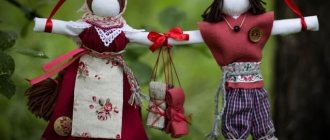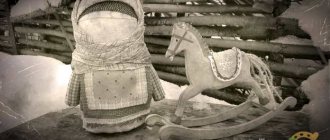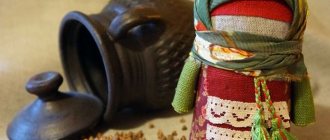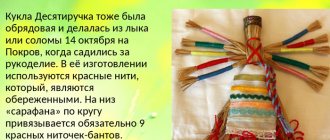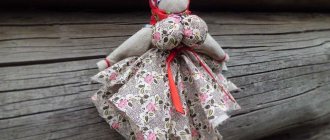Lyalka motanka is a special type of Slavic doll made from fabric with different fillings using the winding method. Hence the name. Rag dolls became an important part of Slavic culture. They were made to protect themselves from visible and invisible evil, to become luckier, richer, happier. There are a huge number of traditions associated with dolls that have survived to this day.
This article will tell you a lot of interesting things about this type of amulets, teach you to distinguish motanki by external signs and select spells for activation. This information will be very useful when you decide to make a fabric doll with your own hands.
Kula motanka among the Slavs and its history
Motanka dolls appeared a very long time ago. According to historians, this happened at a time when people learned to process flax, turning an ordinary plant into fabric for clothing.
Initially, dolls, now considered a children's toy, had a completely different purpose. They were created with the goal of warding off bad energy from a person, as well as attracting good energy. Some motanki embodied the faces of deities, others symbolized a good spirit, and still others depicted the person himself, helping to fool evil spirits, diverting attention to themselves.
The Slavs made amulets in the form of takani dolls to protect themselves from visible and invisible evil, to become luckier, richer, happier.
The Slavs made dolls from a variety of materials. Ash, vines, tree branches, and fabric were used. The latter material took root best in Rus', because fabric amulets, unlike herbal ones, can be refreshed by washing or unraveled, making new ones out of them. Slavic amulet dolls contain many ancient traditions associated with superstitions, holidays, customs, fears and hopes of our ancestors.
How to use a fabric doll
Amulet dolls made of fabric were used by the Slavs everywhere. They were made for a whole family or for an individual. Motankas were received as gifts by people of any age and status. Children, women and men - everyone could receive their own amulet, traditionally made by a relative. Sometimes it was a sister, in other cases the eldest woman in the family, and sometimes even relatives of the husband or wife.
The reasons for making them were very different - for a holiday, for good luck, for protection from damage and the evil eye, for the fulfillment of desires, or as a talisman for a certain personal event.
Folk rag dolls had unique external differences and were not only popular, but also revered. Family amulets were treated with special reverence - they were placed in the most visible and clean place in the house, regularly cleaned of dust and accumulated negativity, and also passed on the reels from generation to generation.
Usually this fate awaited dolls who attracted positive energies. But protective dolls were burned to get rid of the evil that the rag amulet had taken upon itself. It was customary to carry personal protectors with you - in your pocket or bag. Among these, for example, are the doll Happiness and the Plantain. Some of them were allowed to be touched only by the owner and the craftsman who made the amulet.
Master class for parents and children on making a motanka doll “Blessed Woman”.
Master class for parents and children on making a motanka doll “Blessed Woman” .
Today, the interaction of preschool educational institutions with parents is an important component in the work to overcome difficulties in the development and upbringing of preschoolers. Only in close cooperation based on mutual understanding between teachers and parents can high results be achieved.
One of the tasks in working with parents is to involve parents in participating in the life of the kindergarten through the search and implementation of the most effective forms of work. To work with parents, as participants in the pedagogical space, we chose a form called “Master Class”. In our opinion, this is the most convenient form, where theoretical knowledge goes in parallel with the development of practical skills and abilities.
The main advantages of the master class are a unique combination: a short theoretical part, individual work aimed at acquiring and consolidating practical knowledge and skills. A master class is an opportunity to get acquainted with new technology, new techniques and proprietary developments.
Goal and tasks:
-give an idea of the different types of homemade dolls, their purpose, role in the lives of children and adults;
-introduce parents to the technology of making dolls using non-traditional techniques, improve practical skills in making them;
-learn to understand each other, discuss the process of joint activities and evaluate the result;
- make you want to make a doll out of threads with your children.
Dear mothers, thank you for taking the time and coming to our master class. I would like to wish everyone patience, inspiration and creative success.
Today I want to introduce you to dolls made by hand from simple materials. Coming from our grandmothers, from time immemorial they radiate warmth and joy. The motanka doll, or, as it is also called, the knot doll, got its name because of a specific manufacturing technique - winding. Thread dolls are the most common. Dolls were not only played with - they helped a person throughout his life: calendar rituals were performed with them, they were at weddings and at the birth of babies. They were given as birthday gifts, fairy tales were made up about them, and joys and hardships were shared with them. The appearance of the doll is associated with the beginning of flax cultivation, thus we can say that the folk rag doll-motanka is about 5000 years old. And not only in Russia can you find such an ancient rag doll - it is popular in many countries. This not a simple toy protected its owner from adversity and trouble. According to popular beliefs, amulets dolls have magical properties. The first such doll was made for a baby and placed in the cradle. Nowadays we have a custom of tying a red woolen thread to a baby’s hand, but in the past we made dolls for protection. Little children carried them with them, and older ones placed them around the house. The dolls were passed down from generation to generation along with traditional techniques for making them, which is why they have been preserved. The face of the doll was not painted, because it was believed that an evil spirit could move into it, which in the future would have a bad influence on the owner and the house. They “twisted” the dolls while being in a good mood, put on smart clothes, and cleaned the house. They tried to put a piece of their soul into each doll. In many houses there were up to a hundred of them, which indicates their importance. Every child had his own doll. As a rule, the making of dolls was passed down by grandmothers, mothers, and from elders to younger ones. Folk toys were made without any patterns or drawings. The sizes of the dolls were different:
- elbow dolls - from the elbow to the end of the middle finger;
- along the palm - from the end of the middle finger to the wrist;
- across the palm - i.e. the width of four fingers or they are sometimes called finger puppets - i.e. the size of your middle finger. Toy figures are always individual and unique.
Play dolls.
Play dolls were intended for children's amusement.
They were divided into stitched and rolled. Rolled up dolls were made without needles and threads. A thick layer of cloth was wrapped around a wooden stick and then tied with a rope. Then they tied a head with handles to this stick and dressed it in elegant clothes. Playing dolls include spinning dolls, which were made very simply.
Dolls are a talisman.
A talisman is an amulet or a magic spell that saves a person from various dangers, as well as an object on which the spell is cast and which is worn on the body as a talisman.
Ritual dolls.
The Russian land is rich in rituals.
Ritual dolls were revered and placed in the hut, in the red corner. They had a ritual purpose. And in order for the house to be nourishing and rich, the mistress of the house made a grain doll, or krupenichka. It was done after the harvest. The doll is based on a bag of grains collected from the field. They stuffed it with different grains. The woman also made this doll so that she could have children. Zernovushka dolls.
Zernovushka dolls were considered the main dolls in the house, since they were the guardians of what the hard work of the whole family had been invested into. Such dolls contained the best selected grain from the harvest, which was used for sowing in the spring. In order to protect the grain from rodents and insects, the Zernovushka dolls were revised several times over the winter, the bags were treated with saline solution, and the grain was sorted out. And the Zernovushka dolls were an indicator of prosperity: a guest entering the house could easily determine from these dolls whether the family was living in prosperity
The dolls were not left on the street, not scattered around the hut, but were kept in baskets, boxes, and locked in caskets. They were taken to gatherings and visits. Fairy tales were written about dolls, in which they were imagined as magical helpers.
Today we will make a doll of the Well-Being, which will preserve our love for our children and leave a memory of our joint creativity.
Progress:
To make a doll you will need:
- yarn 2-3 colors,
-ribbons, braid,
-thick cardboard (book)
1. To make the head and body of the doll, take threads of the same color and wind them around a rectangular object (book). We make 30 turns around the length of the book. We cut on one side of the winding. We carefully remove it.
2. Take yarn of a different color. This will be the doll's hair. We do the same.
3. We fold our threads crosswise and form the head of the doll. Hair can be braided in pigtails.
4. We make the doll’s arms from the third skein of thread. We wind the threads the width of the book. We make 30 turns. We cut on one side of the winding. We carefully remove it. Stepping back 2cm from the ends of the yarn, tie it tightly with thread of the same color. Cut on the other side. We made hands - the doll's blouse.
5. Divide the pink yarn in half. Insert blouse handles into the middle. Tie a pink thread around the doll's waist.
Align the hem of the doll, cutting off excess threads. Next we design the doll.
Types of motanka dolls and their meaning
Motanka dolls, like Slavic dolls made from other materials, are divided into three types:
- gaming;
- ritual;
- amulet;
The first dolls made by our ancestors had a sacred meaning. But then some of them began to be used as toys for children. Ritual dolls were made for important holidays: Maslenitsa or Ivan Kupala.
But the Slavs sought to receive the blessing of the gods not only on holidays, but also on ordinary days. That is why the most popular type of dolls has become protective reels. Fabric, as the cheapest raw material, was available to people of any income. This influenced the fact that rag dolls, called motankas in honor of the manufacturing method, were made most often in Rus'.
There are quite a lot of types and names of motanka dolls, which is explained by their popularity. Each has its own purpose, manufacturing rules and special properties. Let's get acquainted with the most popular ones.
One of the most common reels was the Herbalist. A rag female figurine was filled with various herbs. Most often, they have healing properties or the ability to repel evil spirits. The pagans believed that evil spirits were capable of bringing misfortune and illness to a person, so in some cases they used herbalism, combining different plants for enhanced protection.
The herbalist could become a family amulet or personal protector. In the latter case, the doll was made during illness, placed in the bed of the sick person, and when he recovered, the motanka was burned.
Some fabric figurines were filled not with grass, but with cereals. A doll with such contents was called Zernovushka or Krupenichka. Her task was to improve the well-being of the family. But she did not care about money, but about the presence of well-fed dishes on the table.
Each protective motanka doll has its own special task. The dolls Krupenichka and the peasant Bogach take care of the availability of well-fed dishes on the table.
There was a special tradition of filling Krupenichka with buckwheat after the harvest. It was also stuffed with rice, pearl barley and oats. Each of these grains had its own significance, but the overall purpose of creating Zernovushka was to provide food. The doll also helped improve the harvest. The best grains collected that year were hidden in a rag amulet and the fields were sown with it for the next year.
Lovebird dolls often appeared in Slavic homes. They were given to newlyweds as a wedding gift to protect and strengthen the union, and to wish happiness in family life. To attract good news, they used the Bell winder, and to fulfill wishes, they made a special doll for good luck, which fit on half of the palm.
Features and secrets of the amulet
A rag doll amulet must be made in accordance with the special rules that guided our ancestors. Many people ignore these parting words, thinking that they arose out of superstition. But these rules are ancient traditions handed down to us by relatives from the past, they should be respected.
If you want to make a correct and strong amulet in all respects, you should not forget about these rules.
For a fabric doll to turn into a talisman with magical properties, be sure to follow the rules for its creation.
Here are some of them:
- Motanka dolls are created without the use of sharp objects. No scissors or needles. It is difficult to make such a talisman without a needle at all, but the rules allow preliminary preparation of materials. Before making the doll's body, prepare the clothes - sew and cut everything you need, and then put the tools aside.
- Finished body parts cannot be sewn together. Just fasten with threads. Natural, of course. Any artificial element will spoil the natural energy of the amulet.
- Motanks are not given faces - noses, lips, eyes should not be marked on their faces, otherwise evil spirits can enter the doll’s face and cause harm to its owner.
- The doll's head must have a headdress. Nowadays women rarely wear them, preferring to show off their hair. But Slavic women hid them under a scarf, because they believed that loose braids contributed to the outflow of energy, which would be taken away by unkind people or dark forces.
- The color of the thread used to create the reel is also important. According to tradition, the elements of the trap figurine were held together with red threads. It was believed that this color could protect a person from evil and give him vitality. The shades used in the clothes of the dolls played a similar role. For example, green often appeared on the clothes of healing dolls, red on amulets for family happiness, and yellow on motankas that lured well-being or granted wishes.
Knowing these secrets, you can put them into practice when making your amulet. But the main difficulty lies not in following the established rules, but in believing in the amulet. Only sincere faith and a positive attitude can charge the doll so much that it will turn it into an attribute of good luck and a powerful protective artifact.
Important rules for making a magic toy
To make a motanka doll truly filled with energy, you should familiarize yourself with the recommendations.
What is important to know when creating a motanka doll
Wrapping a skirt around a doll
Tips for creating a talisman:
- One of the main conditions for creating a doll is that it must be knitted by a craftswoman on any day except Friday, Sunday and holiday.
- The amulet must be created in one day.
- The mood and well-being during the manufacturing process should be good.
- Before starting work, it is recommended to tune in and imagine the future amulet, filling the image with goodness and love.
- It is important to work in a headscarf so that no hair from your head accidentally gets caught in the amulet.
- It is better to sew elements of clothing in advance; they are not allowed to be sewn to the doll itself. They should be fastened together with strong natural thread.
- In order for the amulet to receive the correct charge, it should be made from scraps of clothing worn by the person - the future owner of the amulet. If the doll is intended for a child, you should use things from the parents. You should not use pieces of fabric from things in which you had to endure illness or poor mental health.
- The doll must be filled by the master with straw, pine cones, dried flowers, flax, twigs, seeds, nuts, and grain. If there is no straw, it is recommended to replace it with cotton wool. You should not use synthetic types of materials.
You might be interested in this: Colored paper and cardboard dogs - craft options
Herbs for filling the doll
Note! In connection with the long-standing assertion that through loose hair a woman’s energy can pass to evil spirits, the doll’s head must be covered with a scarf, as female representatives do in life.
How to make a talisman magical
To make a motanka magical, before starting work you should decide on the purpose of its creation. It is important not to confuse your thoughts, as the result will not be effective. Most often it is customary to create a product:
- from the evil eye;
- to help treat diseases;
- to protect the family hearth.
Each amulet has its own moon phase:
- the full moon is the optimal time to protect the family hearth;
- waning moon - promotes rapid recovery;
- waxing moon - brings a successful harvest.
Correct selection of colors for a home amulet:
- the use of green and golden shades helps attract wealth, health and prosperity;
- red color - to happiness and love in the family;
- blue tones will help in achieving career success, adding self-confidence;
- white color is a symbol of purification and healing, as well as the beginning of a new path;
- the use of black will help get rid of damage, evil eyes, failures, and diseases.
Motankas with a predominance of red in clothing - a symbol of love and family happiness
Mastera have since ancient times sought to enhance the energy of the amulet due to the secret meanings of the embroidery elements:
- to attract wealth and prosperity you need to embroider a rhombus;
- with the help of embroidered cornflower on clothes you can be cured of eye diseases;
- when making a motanka for a male person, as a gift you can make embroidery of oak leaves, which symbolize physical and spiritual endurance;
- to avoid colds, you should embroider hops;
- selfish, unclean thoughts and evil eyes will be avoided if there is a fiery spinning cross on the doll’s clothes.
Experienced craftswomen make talismans so that they are filled with special magical meaning, adhering to the following rules:
- It is recommended to carry out the winding process on your knees, not on the table;
- winding the threads should be done in the direction of the spiral solar movement, with the help of which rebirth and growth follows;
- the number of thread windings must be odd;
- It is forbidden to cut the thread, it must be as long as possible;
- It is allowed to make only one knot in the navel area, which symbolizes the beginning of a new life; when tying it, a wish should be pronounced;
- The thread to create a talisman should be used in red, since it is this color that helps protect a person from evil spirits and has a large charge of vital energy.
You might be interested in this: Making slimes with light plasticine yourself
Red thread for winding
Note! One of the popular dolls is Maslenitsa. It is customary to create it precisely on the days of this holiday. It is a talisman for the entire next year.
DIY fabric amulet doll
On the pages of our website you can find detailed master classes on making motanka dolls. After familiarizing yourself with them, you can make your own Herbalist, Krupenichka, Podorozhnitsa, Bell and other wonderful dolls according to all the rules.
Here we will dwell on these very rules that you need to follow when making a talisman with your own hands:
You only need to start creating a motanka auberge doll with your own hands in a good mood.
You cannot start working on the amulet if you are not feeling well. This way you will fill it with your negative emotions - pain, anger, disappointment, fatigue. Can an object with such energy bring happiness?
- Creating a motanka doll should occur in one stage. No putting off work until the evening after watching any TV program, and especially not shaking the amulet during lunch. When you sit down to reel, concentrate on your work, getting rid of all irritants.
- Most often, motanki are made during the waxing moon. This helps to additionally charge the doll with energy. However, if the doll is made not to attract something new, but to preserve the old, then it will be better if its production falls on the day of the full moon.
These rules do not require much effort, but at the same time guarantee the correct operation of the amulet, so do not forget about them.
Reeling Rules
There is one more manufacturing rule that relates specifically to reels. It is not used for dolls made of other materials, as it is related to the method of winding the threads.
Having chosen natural threads and chosen the color, do not think that this is enough. You need to think in advance and measure the length of the threads so that when tying the doll’s arms and legs to the body you no longer need to use scissors. Separately, it is worth mentioning how to wind the thread correctly.
The Slavs paid attention to the direction of winding threads and the direction of the rays of solar amulets. There are only two types of direction - with the sun and against it. The latter was sometimes used to create body amulets, but never when creating reels. They need to be wound only according to the movement of the heavenly body, that is, clockwise. This will help charge the doll with life-giving energy and give her strength.
Decorating a motanka doll
You can enhance the magical properties of the motanka doll by decorating it with special protective symbols in the form of embroidery on clothes.
Very often, motankas contain ancient symbols, their meaning complementing the properties of the pupa. Now some craftswomen hang small wooden pendants with signs carved on them on their dolls. But before, such symbols were embroidered. Usually embroidery decorated the apron of the motanka, and at times - her knapsack or even her scarf. On men's motankas, embroidered patterns and symbols appeared on shirts.
Almost never did needlewomen apply one single sign to the fabric, leaving the space around it empty. Most often these were combinations of symbols and curlicues, complementing each other. Even the smallest, insignificant details had their own meaning. The shades of the thread complemented it. A knowledgeable person could at first glance, by the color of the embroidery and its motifs, determine the capabilities of the amulet.
How to make a talisman doll?
Necessary materials
The main material for the toy is linen thread.
To make a talisman “for health” with your own hands, you will need the following items:
- a skein of linen threads of natural color;
- cardboard or board 15 cm wide;
- a spool of scarlet threads;
- large sewing needle;
- scissors.
Stages of work
The scarlet thread can be replaced with a light green thread so that the amulet will also make the owner happy, or blue if the illness is of a psychological nature. Blue will help heal mental pain.
The “health” amulet is made according to the following step-by-step instructions:
Taking a red thread, you need to make a neck for the toy.
- 150 and 50 turns of linen threads are wound separately onto the cardboard. The first ones will go to the body, and the others to the arms and hair. The threads are cut along one edge.
- A thin bunch is taken, tied at the tip with a knot, and then divided into equal halves and separated in 2 opposite directions.
- A thick coil is laid on top, which will soon become the body of the pupa. You will get two tails hanging from different sides.
- The 2 hanging parts of the thick winding are connected and tied with scarlet thread 2 cm below the thin bundle to form a neck.
- One tight braid is woven from thin ponytails with the disclaimer: “Get well soon!”
- A third thin bunch is taken from the cardboard. Stepping back 1 cm from the end of the threads, you need to tighten the scarlet thread. Next, the braid is braided until the same indent remains on the other side. The bundle is tied with thread. The ends are allowed to be trimmed.
- The body is divided into 2 parts and the arms are inserted inside. The thread used to secure the head is used to tie the sternum with an overlapping cross on both sides of the doll.
- The waist is tied.
- The forehead is wrapped with a thread and tied with a knot at the back of the head.
How to make a talisman magical
The finished rag amulet will remain a cute craft if you do not activate it. To charge amulets, the Slavs used natural elements or spells. The best way to make a motanka doll magical is to combine these methods.
A special spell is read over the motanka, and then it is left in a sunny place or, if the weather is cloudy, the sun is replaced with candles. This must be done carefully, because a small flame can instantly ruin the reel.
The finished rag amulet will remain a cute craft if you do not activate it.
Our ancestors used a variety of conspiracies. Their meaning boiled down to what a person wants to get from the amulet. The Slavs asked the motanka for protection, a good harvest, healing from illnesses or the fulfillment of desires. So you can find a conspiracy that suits the occasion and pronounce it.
For example, like this:
(Doll’s name), keep the light, protect me, drive away the darkness.
This plot is well suited for a personal talisman with protective functions. And the next one is for family protective reels:
Be a support, be a shield, protect your family and home, take trouble and the evil eye away from us.
Any of the conspiracies can always be replaced with your own, unrhymed request. Be sure to clearly formulate it by writing it down on a piece of paper and read it to yourself several times before voicing it in front of the reel.
